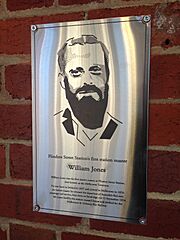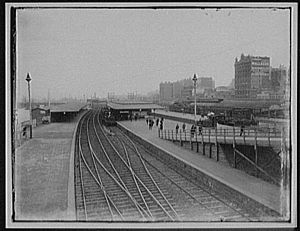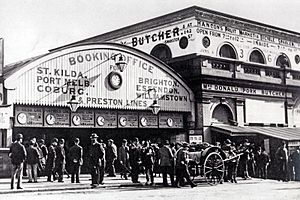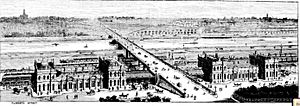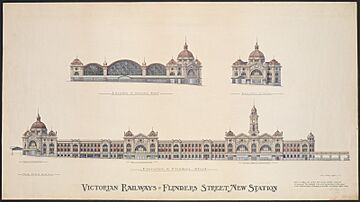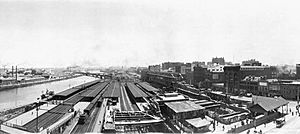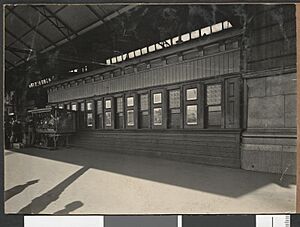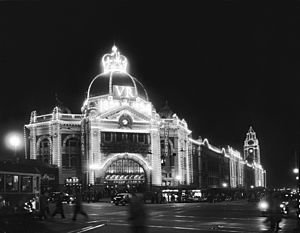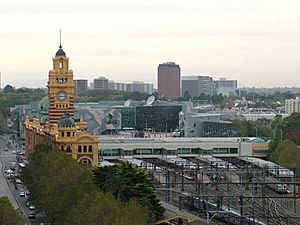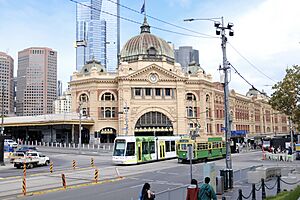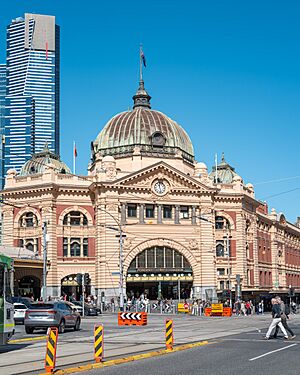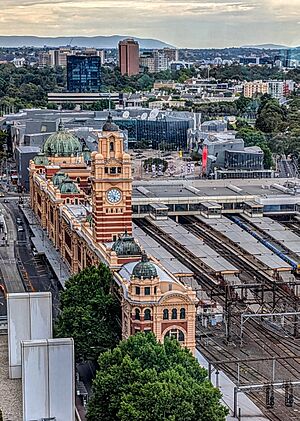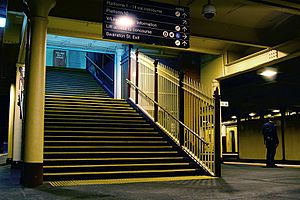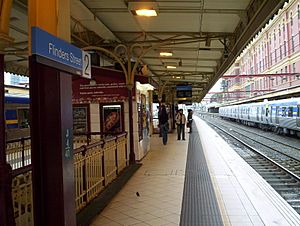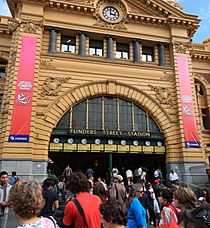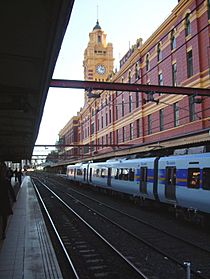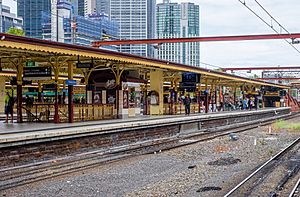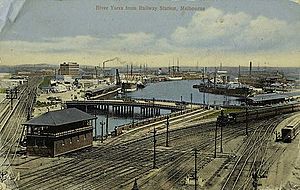Flinders Street railway station facts for kids
Quick facts for kids
Flinders Street
|
|||||||||||||||||||||||
|---|---|---|---|---|---|---|---|---|---|---|---|---|---|---|---|---|---|---|---|---|---|---|---|
| PTV metropolitan and regional rail station | |||||||||||||||||||||||
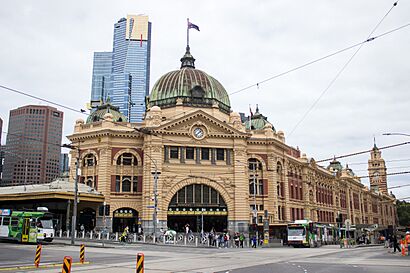
Flinders Street station main entrance, corner of Flinders and Swanston Streets,
February 2021 |
|||||||||||||||||||||||
| Location | 207–361 Flinders Street Melbourne, Victoria 3000 Australia |
||||||||||||||||||||||
| Coordinates | 37°49′05″S 144°58′01″E / 37.818078°S 144.96681°E | ||||||||||||||||||||||
| Owned by | VicTrack | ||||||||||||||||||||||
| Operated by | Metro Trains | ||||||||||||||||||||||
| Line(s) |
|
||||||||||||||||||||||
| Distance | 1.23 kilometres from Southern Cross |
||||||||||||||||||||||
| Platforms | 13 (plus one removed) | ||||||||||||||||||||||
| Tracks | 15 | ||||||||||||||||||||||
| Train operators | |||||||||||||||||||||||
| Connections |
|
||||||||||||||||||||||
| Construction | |||||||||||||||||||||||
| Structure type | At-grade | ||||||||||||||||||||||
| Parking | None | ||||||||||||||||||||||
| Bicycle facilities | None | ||||||||||||||||||||||
| Other information | |||||||||||||||||||||||
| Status | Premium station | ||||||||||||||||||||||
| Station code | FSS | ||||||||||||||||||||||
| Fare zone | Myki Zone 1 | ||||||||||||||||||||||
| Website | Public Transport Victoria | ||||||||||||||||||||||
| History | |||||||||||||||||||||||
| Opened | 12 September 1854 | ||||||||||||||||||||||
| Electrified | 28 May 1919 (1500 V DC overhead) | ||||||||||||||||||||||
| Previous names | Melbourne Terminus | ||||||||||||||||||||||
| Traffic | |||||||||||||||||||||||
| Passengers (2019-2020) | 21.504 million |
||||||||||||||||||||||
| Passengers (2020-2021) | 8.528 million |
||||||||||||||||||||||
| Passengers (2021–2022) | 11.393 million |
||||||||||||||||||||||
| Passengers (2022–2023) | 18.793 million |
||||||||||||||||||||||
| Passengers (2023–2024) | 20.345 million |
||||||||||||||||||||||
|
|||||||||||||||||||||||
|
|||||||||||||||||||||||
|
Building details
|
|||||||||||||||||||||||
| General information | |||||||||||||||||||||||
| Status | Complete | ||||||||||||||||||||||
| Type | Railway station terminus | ||||||||||||||||||||||
| Architectural style | Federation/Edwardian Period Baroque | ||||||||||||||||||||||
| Elevation | 20.6 metres (68 ft) AHD | ||||||||||||||||||||||
| Construction started | 1900 | ||||||||||||||||||||||
| Completed | 1909 | ||||||||||||||||||||||
| Cost | £A 514,000 | ||||||||||||||||||||||
| Technical details | |||||||||||||||||||||||
| Material | |||||||||||||||||||||||
| Design and construction | |||||||||||||||||||||||
| Architect | James W. Fawcett | ||||||||||||||||||||||
| Architecture firm | Fawcett and Ashworth | ||||||||||||||||||||||
| Engineer | H.P.C. Ashworth | ||||||||||||||||||||||
| Official name | Flinders Street Railway Station Complex | ||||||||||||||||||||||
| Criteria | A, E, F, G | ||||||||||||||||||||||
| Designated | 20 August 1982 | ||||||||||||||||||||||
| Reference no. | H1083 | ||||||||||||||||||||||
| Heritage Overlay number | HO649 | ||||||||||||||||||||||
Flinders Street railway station is a very busy train station in Melbourne, Australia. You can find it at the corner of Flinders and Swanston streets. It's the most active train station in Victoria!
This station helps people travel all over Melbourne using the city's train network. It also connects to 15 different tram routes. Plus, you can catch regional trains to Gippsland from here.
The station first opened in 1854. This makes it the oldest train station in Australia, even though the building you see today is newer. It sits right next to the Yarra River in the heart of Melbourne. Today, it has 13 platforms and covers a huge area, stretching over two city blocks.
Flinders Street station is a major hub for Metro Trains and V/Line regional services. In 2023-2024, over 20 million passengers used the station. It was once known as the busiest passenger station in the world back in the 1920s!
The main platform at Flinders Street is one of the longest in Australia. It's also one of the longest in the world! Many trams connect with trains here. It's also home to two of Melbourne's busiest pedestrian crossings. One of these is a special "pedestrian scramble" at Elizabeth Street.
The station building you see now was finished in 1909. It's a famous symbol of Melbourne. Its unique Edwardian style, with its big dome, arched entrance, tower, and clocks, is easy to spot. There's a fun myth that the design was actually meant for a station in Mumbai, India, but the plans got swapped!
If someone in Melbourne says, "I'll meet you under the clocks," they mean the row of clocks above the main entrance. These clocks show when the next trains are leaving. Another common meeting spot is "on the steps," which refers to the wide staircase below the clocks.
Since 1982, Flinders Street station has been listed on the Victorian Heritage Register. This means it's a very important historical building.
Contents
Station History
The First Train Station
The very first train station on this spot was much simpler. It was made of weatherboard sheds. It opened on 12 September 1854. The Lieutenant-Governor, Charles Hotham, officially opened it. This was Australia's first city train station. On opening day, the first steam train trip in Australia happened here. The train traveled to Sandridge, which is now Port Melbourne.
At first, people called the station "Melbourne Terminus" or "Melbourne, Flinders Street." Over time, everyone just started calling it "Flinders Street." This became even more common when Prince's Bridge station opened nearby in 1859.
The first station had just one platform, about 30 meters long. It was next to the Fish Market. In 1877, another platform was added. Then, in 1879, more buildings and a telegraph station were built. The first signal boxes, which control train movements, opened in 1883. By the 1890s, a third platform was added.
Melbourne had two other early city stations: Spencer Street and Princes Bridge. Spencer Street served lines to the west. It was connected to Flinders Street by a railway line in 1879. Princes Bridge station was separate but later joined with Flinders Street. Today, Federation Square is where Princes Bridge station used to be.
Building the Famous Station
By the 1880s, it was clear that a new, bigger station was needed. A design competition was held in 1883. However, the winning design was never built.
Later, in 1899, another design competition took place. Two railway employees, James Fawcett and H. P. C. Ashworth, won with their design called Green Light. Their plan included the large dome and tall clock tower we see today.
Work on the station's tracks began in 1900. The main building's foundations were finished by 1903. In 1904, while still being built, the plans changed a lot. Instead of one big roof over all platforms, individual roofs were chosen. A fourth floor was also added to the main building for more office space.
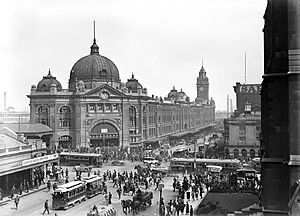
Construction of the building itself started in 1905. It was originally meant to be stone, but that was too expensive. So, red brick with cement details was used instead. Grey granite was used for parts of the ground floor. The dome's construction began in 1906. It needed strong foundations because it was built over train tracks.
The station was mostly finished by mid-1909. It officially opened in 1910. The new building had many shops and offices. The top floor was built for the Victorian Railway Institute. It had a library, gym, and a lecture hall that became a ballroom. These rooms have been empty since the 1980s.
For some years, the station even had a creche (a nursery for children) with an outdoor playground on the roof. Since 1910, a hat shop called "City Hatters" has been in the basement next to the main entrance.
The first electric train service started from Flinders Street in 1919. By 1923, it was thought to be the world's busiest station. It handled 2,300 trains and 300,000 passengers every day! In 1954, the Degraves Street subway was extended. This created Campbell Arcade.
Saving the Station
From the 1960s to the 1970s, there were plans to knock down or rebuild the station. It had become quite run-down. In 1962, there was a plan to replace the clock tower with a 60-story office building. But this never happened.

In 1972, another plan was revealed to build a huge complex of shops and offices over the station. However, many people strongly opposed these ideas. A special "green ban" by construction workers helped save the station. This led to people realizing how important and beautiful the station's architecture was. By 1976, it was protected by the National Trust of Australia. It was then listed on the state Heritage Register in 1982.
In 2011, the Victorian Government held a competition to find new ideas to refresh the station. Many designs were submitted, but no major changes were made.
Modern Upgrades
The main concourse area has changed a lot over the years. In 1980, TV screens were added to each platform to show train information. In 1982, a big refurbishment project began. It added the first escalators to platforms 2 and 3. New public toilets were also built. The main concourse was tiled and made larger.
In 1993, the Elizabeth Street subway was extended. Conservation work also happened on the main building. The outside was repainted, and the beautiful stained-glass windows were fixed. More changes in the late 1990s added access to platform 1 and replaced ramps with escalators and elevators.
Between 1997 and 1998, the tracks east of the station were rebuilt for the Federation Square project. This reduced the number of railway lines and switches.
The station continued to be updated. In 2007, the roof was fixed, and platform 10 got escalators and a lift. New LCD screens were installed to show train information. In 2009, an escalator replaced a lift to platforms 12 and 13.
In 2015, the government announced $100 million for urgent repairs and upgrades. This included fixing platforms, entrances, and toilets. The outside of the main building was also restored. By July 2017, the station was almost completely repainted in its original 1910 colours. The bright yellow was replaced with softer stone and red shades.
In 2018, the Elizabeth Street pedestrian subway was renewed. The area in front of the main entrance was also made larger. New safety barriers were installed to protect people walking there.
Town Hall Station Connection
Flinders Street station is expanding! A new station called Town Hall is opening nearby in 2025. It's located under Swanston Street. This new station will have several entrances in the surrounding area.
Town Hall station is part of the Metro Tunnel project. It will connect directly with Flinders Street. In November 2017, the new station was named Town Hall after the nearby Melbourne Town Hall. Major construction began in 2018.
The new Town Hall station will connect to Flinders Street station through an underground walkway. This walkway goes through the existing Campbell Arcade and Degraves Street underpass. The design of this connection carefully preserved the historic look of Campbell Arcade.
This connection, called Flinders Link, will allow passengers to easily switch between Metro Tunnel services at Town Hall and Flinders Street services. As part of the project, six lifts are being installed on Flinders Street station platforms 1–10. These lifts will make it easier for everyone to access the platforms via the Degraves Street underpass.
The Degraves Street Subway reopened on 29 January 2025. It had been closed since April 2022 for upgrades. Elevators were added in place of some stairs to the platforms. The exits onto Flinders and Degraves Street will open when Town Hall station officially opens later in 2025.
Station Layout
Flinders Street station has many tracks that go all the way through. This is because of the limited space and how the railway network grew over time. The very first platform was only about 30 meters long. It allowed trains from Port Melbourne to stop there. Later, it was extended so trains from both the east and west could arrive at the same time.
A second platform was added in 1877 as more trains started using the station. More platforms were built between 1889 and 1892. By 1909, there were 11 platforms. Platforms 10 and 11 were extended, creating two new platforms, now numbered 12 and 13.
In 1966, platform 1 at Flinders Street was extended to meet the platform at Princes Bridge. This created one very long platform, over 800 meters long! In 1980, Princes Bridge station officially became part of Flinders Street. Its platforms were renumbered 14, 15, and 16.
Some platforms were closed in the early 1990s. Platform 11 became unused after the Port Melbourne line closed in 1987. Platforms 15 and 16 were removed to make space for Federation Square. Platform 11 was even turned into a bar and restaurant in 2014!
A short platform called the Milk Dock was built in 1910. It was used for milk and other small goods arriving by train. Today, this structure is still mostly there.
Three main walkways connect the platforms. The main concourse is at the east end, near the big dome. It has escalators, stairs, and elevators to all platforms. The Degraves Street subway runs under the middle of the station. It connects to Flinders Street and most platforms. The Elizabeth Street subway is at the west end. It has ramps to most platforms and a stairway to platform 1.
Platforms and Destinations
Sometimes, trains might use a different platform if their usual one is busy.
Platform 1:
- Trains going through the City Loop on the Clifton Hill Group lines. These include services to Eltham, Hurstbridge, and Mernda.
Platform 2 & 3:
- Trains going through the City Loop on the Burnley Group lines. These include services to Lilydale, Belgrave, Glen Waverley, and Alamein.
Platform 4 & 5:
- Trains going through the City Loop on the Northern Group lines. These include services to Craigieburn, Upfield, and Sunbury.
- Also, some trains via Richmond to places like Blackburn and Glen Waverley use platform 4.
Platform 6 & 7:
- Trains via Richmond to East Pakenham and Cranbourne.
- Platform 7 also has V/Line services to Traralgon, Sale, and Bairnsdale (for picking up passengers).
Platform 8 & 9:
- Trains via Richmond to Frankston.
- Platform 9 also has trains via Southern Cross to Laverton, Werribee, and Williamstown.
Platform 10:
- Trains via Southern Cross to Laverton, Werribee, and Williamstown.
- Special event trains to Showgrounds and Flemington Racecourse also use this platform.
- V/Line services to Southern Cross (for dropping off passengers).
Platform 11:
- This platform has been removed and is now a restaurant, separate from the station.
Platform 12 & 13:
- Trains via Richmond to Sandringham.
- Platform 12 also has some trains via Southern Cross to Laverton and Werribee.
Platform 14:
- This platform is not currently used, except for emergencies. It used to be part of Princes Bridge.
Famous Clocks
The special clocks under the main dome show when the next trains are leaving. These clocks have been around since the 1860s! They were first used at Flinders Street and other stations.
When the old station was knocked down in 1904, the clocks were stored. Then, 28 of them were put into the new station in 1910. They were at the main entrance and other entrances.
A railway officer used to change these clocks by hand with a long pole. They would change the clocks about 900 times during an 8-hour shift! In 1983, the original clocks were going to be replaced by digital screens. But people loved the clocks so much that there was a huge outcry! The decision was changed in just one day. The clocks at the main entrance were then updated to work automatically by computer.
The spot "under the clocks" or "on the steps" has been a popular meeting place for people in Melbourne since the station opened. Even though it wasn't designed for meeting, it's a great spot. It's across from the well-known Young and Jackson Hotel and overlooks busy tram routes. Many people meet here even if they aren't taking a train.
There has also been a clock tower at the Elizabeth Street end since 1883. The first one was called the 'Water Tower Clock'. It was moved several times before being put on display at the Scienceworks Museum. In 2014, it was returned to Southern Cross station.
The current Elizabeth Street clock tower was built between 1906 and 1907. It was made by a Melbourne clock maker named F. Ziegeler. It used to need winding every day, but now it runs on electricity. It was cleaned and fixed between 2017 and 2018.
Signal Boxes
Signal boxes are buildings that control train signals and tracks. The first ones at Flinders Street opened in 1883. From the 1900s until 1983, five signal boxes controlled trains coming into the station.
Flinders Street A was at the western end of the station. It controlled all trains from the west. This signal box was damaged by fire twice. In 2009, it was rebuilt as Signal, a youth arts center.
Flinders Street B and Flinders Street C were at the Richmond end. They controlled tracks from Jolimont Yard. These were taken down when Federation Square was built.
Flinders Street D was near the Princes Bridge platform. This brick building is still there today.
Flinders Street E was at Richmond Junction. It controlled the junction and access to train storage areas. This brick building is also still there, under the William Barak Bridge.
Since 1983, train movements at the station have been controlled remotely by a system called Metrol.
How Many People Use the Station?
Flinders Street is the busiest station in Melbourne's city train network. In the year 2023-2024, about 20.35 million passengers used it!
Getting Around: Transport Links
Yarra Trams runs 14 different tram services that pass by Flinders Street. These trams use Flinders Street, Swanston Street, and Elizabeth Street.
| No. | Route | Stop location | Ref |
|---|---|---|---|
| East Coburg – South Melbourne Beach | Swanston Street | ||
| Melbourne University – East Malvern | |||
| Melbourne University – Malvern | |||
| Moreland – Glen Iris | |||
| Melbourne University – Kew | |||
| to North Coburg | Elizabeth Street | ||
| City Circle | Flinders Street | ||
| to West Maribyrnong | Elizabeth Street | ||
| to Airport West | |||
| Melbourne University – East Brighton | Swanston Street | ||
| Melbourne University – Carnegie | |||
| Waterfront City Docklands – Wattle Park | Flinders Street | ||
| Melbourne University – Camberwell | Swanston Street | ||
| Central Pier Docklands – Vermont South | Flinders Street |
See also
 In Spanish: Flinders Street Station para niños
In Spanish: Flinders Street Station para niños


